So you’ve decided to become a home inspector. Now it’s time to roll up your sleeves, find some clients, and start inspecting.
Not so fast, partner.
Before you can get started as a home inspector, you need to get certified. This is a process that varies from state to state, but in nearly every case it involves formal training and an exam. In this section, we’ll give you all the information you need to get certified. While there are different methods for getting certified, at the heart of the process is gaining knowledge.

Get ready — because over the course of training and coursework, you’ll learn everything you need to inspect homes with confidence.
Background for home inspectors
Steps to start a home inspection business
You can’t start a home inspection business overnight. In fact, between learning about the business, getting certified, and forming business relationships, aspiring home inspectors have quite a bit to do. Here are the basic steps you’ll need to take in order to get up and running:
- Figure out home inspector license requirements in your state. These requirements vary by state, but a quick Google search can give you the basic steps you’ll need to take to get certified. For reference, it takes 140 classroom hours in New York to become an approved home inspector there.
- Start training for the exam. Conducting a complete home inspection requires knowledge of construction, foundations, and the basics of engineering. In other words, you’ll need to take some courses, either online or in person.
- In the meantime, start building relationships. You’ll only get business as a home inspector if you have a sizeable network of Realtors who know you and the skills you bring to the table. Going to networking events, such as an event organized by the National Association of Realtors (NAR), is a great way to meet people.
- Pass the home inspection licensing exam in your state. This one’s straightforward. After your coursework, you should be ready to ace this.
- Choose your career path and get started. Whether you’re starting your own firm or starting out at a more established firm, the options for a licensed home inspector are numerous.
How to become a home inspector
As we’ve mentioned, becoming a home inspector takes time and effort. In this blog post, we walk through how to become a home inspector in a bit more detail so that you can hit the ground running and begin inspecting homes.
There are several ways to receive formal training and get certified
When a client brings you into their home for an inspection, they’re trusting you to gauge the safety and functionality of the most important building in their lives. Naturally, you need to prove yourself before you can take on such an important responsibility. So you have to take part in formal training and certification in order to get started.
Here are a few of the ways to get certified as a home inspector:
- Classroom training. Home inspections require you to grasp engineering and construction concepts that can be quite complex. Taking in-person classes with an established educator is a great chance to figure out the basics in a relaxed but engaging setting.
- Field training. When it comes to home inspection training, you often learn by doing. So why not take the chance to head into the field and do some hands-on, real-life inspections of actual homes? When getting certified in New York, the American Home Inspector Training Institute (AHIT) offers this sort of in-the-field training.
- Online home inspection classes. Many aspiring home inspectors come from the world of construction — which means they might already have a full-time or part-time job. In this case, online courses come in handy. They allow you to get the information you need from the comfort of your home. You can also register for online courses as a supplementary resource so that you can review key principles on your own time.
- Continuing education. Home inspection is always changing. New building methods and emerging technologies require you to stay up to date on the latest developments in the industry. That’s why many states offer continuing education for home inspectors. For instance, in Illinois home inspectors are required to receive 12 hours of home inspection instruction every two years. This ensures you’re aware of the latest home inspection information.
Different states look for different levels of training and experience when it comes to home inspection licensing. To learn what’s required in your state, check out this list on the AHIT website. Once you find your state, you can learn more about what AHIT offers in terms of home inspection training. For instance, here’s the training package for aspiring home inspectors in New York.
How does a home inspection differ from a structural engineer inspection?
Home inspection isn’t the only type of inspection out there. It’s important to understand how this type of inspection differs from other comparable inspections.
- How do you define “home inspection”? A home inspection involves a certified home inspector coming to a home and evaluating it based on a certain set of established standards. It involves a visual survey of the home, during which the inspector will assess the condition of the home’s major components — such as the exterior, interior, roofing, electrical system, heating system, cooling system, insulation, and more. It takes two or three hours and is considered a “cursory” view of a home, meaning it isn’t incredibly detailed but is still thorough.
- What is a structural engineer inspection? An engineering inspection tends to be a bit more granular. This means an engineer will come to a home and evaluate the structural condition of the home — such as the foundation, floor structure, ceilings, walls, and roof. Is anything off? Is the home structured to withstand varied weather conditions? Is there physical damage such as cracked drywall? The engineer will then take this data and produce a scaled drawing that determines the structural integrity of the home. They will deliver a written report that includes any pertinent information.
- What sort of training goes into becoming a structural engineer inspector? Simply put, you need to be an engineer to conduct a structural engineer inspection. This requires years of schooling and plenty of hands-on experience.
- So what’s the main difference? Both types of inspection are good for homebuyers to do. In fact, a structural inspection is paramount if you’re buying a larger, older home. Oftentimes a home inspection will be conducted first. If the home inspector finds anything of concern, they will likely refer the homebuyer or homeowner to a structural engineer who can perform a deeper structural analysis.
Overall, these two types of inspections have different but complementary goals. A home inspector can’t do everything a structural engineer inspector can do and vice versa. But together, they can help homeowners ensure their home is as safe and as functional as possible.
What are some other types of inspections?
Home inspections and structural engineer inspections cover only certain criteria. Here are a few other inspections that you might want to familiarize yourself with:
- Disaster inspection. Extreme weather is the norm for certain parts of the country. If you’re in a region that experiences hurricanes, blizzards, tornadoes, or earthquakes, you’ll want an inspection to see how well your home can withstand a natural disaster.
- Chimney inspection. You can have a major fire or smoke hazard on your hands if your chimney is damaged or dirty. For homes with wood-burning fireplaces, a chimney inspection can ensure the chimney’s flue is functional and its brickwork isn’t crumbling.
- Pool inspection. Pools are the site of countless family memories. But before your family dives in, you want to be absolutely sure your pool is safe — from filtering to heating to dreaded leakage.
- Foundation inspection. People don’t live in the Leaning Tower of Pisa for a reason. So we don’t have to tell you what happens if you have a dysfunctional foundation. Before buying a home, many buyers make the wise decision to get a foundation inspection.
- Wood-destroying pest inspection. Termites and other similar wood-destroying pests are a headache for countless homeowners. These pests make complex networks of destruction that can lead to catastrophic outcomes, so an inspection can make a huge difference.
- Asbestos inspection. Thankfully, homes have been built without this dangerous mineral for nearly 50 years. But if you have an older home — built before 1973, specifically — you’ll need to get an asbestos inspection. The same goes for lead paint, which was banned in 1978.
- Mold inspection. Every homeowner’s worst nightmare is mold in their walls. But this can be a common headache that’s best dealt with proactively after an inspection.
- Electrical inspection. While a general inspection will check the electrical box for issues, having an electrician come in and look at the wiring can lead to a much deeper understanding of your home’s electrical setup — and uncover any problems that need to be addressed.
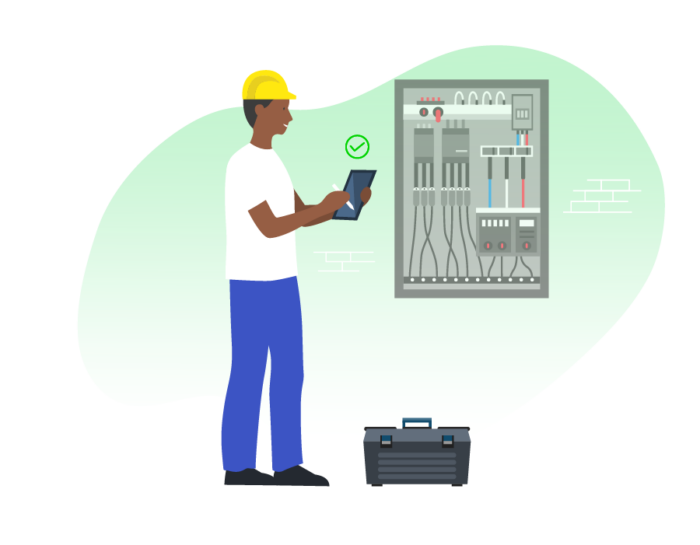
There are many reasons to be familiar with these types of inspections. For one, you might end up referring people to these types of inspectors if concerns come up while you’re conducting a home inspection. In addition, you might want to get certified to take on some of these types of inspections. Or you might want to hire people who are skilled at conducting these inspections to work at your firm.
What should an inspector look for?
It’s hard to sum up what a home inspector does in just a few words. After all, they’re assessing many details of a home while developing a more holistic evaluation of the home’s condition.
In this section, we’ll go into more detail about what home inspectors look for and why this process is so vital for homeowners. We’ll also touch on the sort of professional experience that makes for good home inspectors. (As you can imagine, those with experience in construction and related industries tend to thrive in the home inspection field.) Finally, we’ll provide a checklist for home inspectors to have on hand as they conduct an inspection.
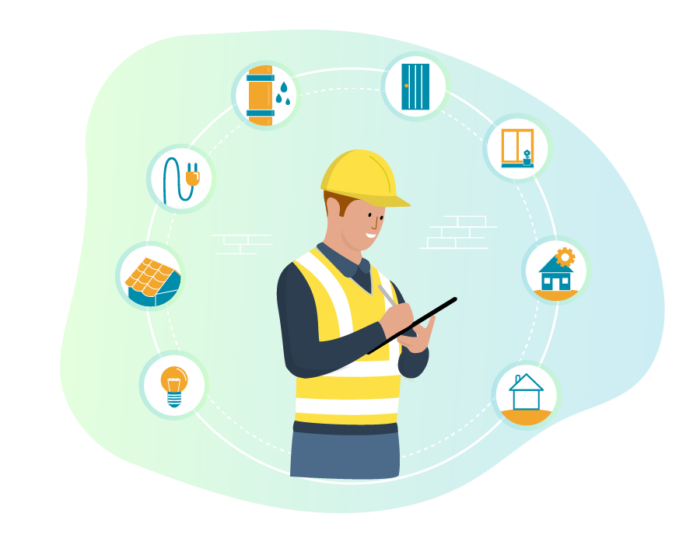
What does a home inspector do, and why is it important?
When we spoke about home inspection training, we outlined the things aspiring home inspectors covered in their preparatory coursework. Remember that list? It ranged from construction and foundations to heating, cooling, and just about everything in between. So here’s a bit about how home inspectors put that knowledge to work and conduct comprehensive home inspections:
- Learning about the home. Before diving into the inspection, you should talk with the buyers about their potential home. Are there any red flags they’d like you to pay extra attention to? Has the seller disclosed any damage that needs to be addressed? Are there features of the home that are particularly important to them? Write these concerns down prior to the inspection so that you remember to keep a close eye on them.
- Starting the inspection. Now that you know more about the home, it’s time to start the inspection. An inspector will look at the condition of the home’s heating and cooling system, the electrical system and interior plumbing system, the walls, floors, ceiling, roof, windows, and doors, the attic, basement, insulation, and foundation. Check out our checklist for inspectors.
- Filling out evaluations. Once the inspection has been conducted, it’s time for the inspector to draft a home inspection report. This report must be entirely objective and truthfully speak to the current condition of the home. This Code of Ethics addresses some of the rules for filling out reports after a home inspection, and these Standards of Practice outline all that should be addressed in a report.
- Speaking with the home buyers. As we’ve discussed, being a home inspector requires customer service know-how. After all, you’re directly interfacing with individuals seeking your services, and much of the process will involve working with the home buyers.
Sometimes these buyers will accompany you on your inspection, ensuring you’re taking a comprehensive look at the home. They can also outline red flags in real time this way, and you can tell them a bit about the home as you go along.
Alternatively, all of this can happen after the fact. For instance, if there’s an issue with the electrical system, you can write out the problem in your report, and then give the home buyers a hands-on demonstration of how the electrical system is malfunctioning. This is an extra service that gives the home buyer crucial information and peace of mind from an expert.
Why is this process so important? Because it empowers home buyers. It helps them intimately understand the shortcomings of the home they’re about to buy.
After an inspection, they have the power to renegotiate with a seller based on your report. They can also convince the seller to fix these problems prior to their move-in. And if the home buyer thinks the problems that come with this home might be too much of a headache, they can walk away from the deal.
Home buyers rely on a thorough home inspection.
How important is it to have experience in construction or other related industries before becoming a home inspector?
What fields tend to attract home inspectors? As you can imagine, those from the construction industry are particularly ready to take on home inspection. After all, they know how homes are built — so they know what to look for when assessing a home’s plusses and minuses.
Transitioning from construction to home inspection. After working in a construction trade for a while, you build a great deal of experience related to the function of a home. A lot goes into building a house — and the average home buyer might not be aware of all the insulation and ventilation behind the walls or the intricacies of the electrical system. Construction workers do.
If you want to go from working on construction sites to working in finished homes, you might want to transition to a career in home inspection.
Can you do both? Yes, sometimes construction workers are also licensed home inspectors. Both are time-intensive jobs, so while it’s a difficult balance, it might be feasible to work full-time in construction then inspect homes on the side or vice versa.
What other fields produce home inspectors? Although it’s less common, someone may want to transition from real estate into home inspection (or vice versa). While they call for different skills, they are both customer-facing and deal with the condition of homes, so it’s not a massive stretch to transition between these careers.
Most home buyers want their home inspected by someone with experience in construction. No matter what their job might have been in the construction industry, a home inspector who has been in that field reassures a buyer that their home is being overseen by someone who intimately knows what a good (or not-so-good) house looks like.
Home inspection checklist for inspectors
There are no shortcuts when it comes to conducting a comprehensive home inspection. In this home inspection checklist, we outline every part of the home that an inspector should be sure to check. And in each part of the house, we mention some of the questions a home inspector should ask as they evaluate the condition of these features.
Common repairs needed after a home inspection
After a home inspection, you might find problems that need to be addressed right away. Either the buyer will tell the seller to fix these before move-in, or they’ll renegotiate the price, and the buyer will handle the fixes once the home is theirs.
Here are a few of the common repairs needed after a home inspection:
- Installing new siding, repainting, or fixing brickwork. A home’s exterior takes a lot of wear and tear. Between extreme weather and the simple ravages of time, you might find that a home’s siding, paint, or brick has seen better days. While this serves a functional purpose, it can also be cosmetic. After all, the first part of a home someone sees is its exterior — so fixing it could help boost the property value as well as address structural issues.
- Replacing the air conditioning. An old air-conditioning system can be difficult to deal with. It can break down too often or leak water, which is a big headache. And considering how much better a newer system can be, oftentimes a buyer will opt to replace an air-conditioning system before moving in.
- Fixing faulty wiring. After looking at the electrical system, you might find that some wires are defective. If this is the case, an electrician will have to come in and fix any ongoing issues so that the electrical system of the home will be at 100 percent.
- Installing new windows. Cracks in a window can cause drafts and lead to higher energy costs. A lot of home buyers see it as a worthwhile investment to get new windows that close and open properly and don’t let heat escape or cool air seep into the home.
- Repairing the roof. Just like a house’s siding, paint, or brick, a roof takes on a lot of wear and tear. If shingles are missing or simply worn down, a home buyer might opt to fix any roof defects. Again, fixes to your roof also make your house look newer and fresher, which could raise the home’s property value.
Inspecting a home is only half the battle. Acting on any defects you find is a great way to improve the home and ensure the new residents of the home are satisfied with their purchase.
Must-have home inspection equipment
Here are the tools every home inspector needs in their toolkit
There are some tools every home inspector needs — not just to conduct their inspection effectively but also to stay safe as they do so. After all, there are plenty of hazards when checking the condition of a home. This equipment has helped many inspectors do their job to the best of their ability and stay safe while doing it:

- Safety glasses. From dust to cement particles, there are lots of small elements you can come into contact with when doing an inspection. Safety glasses are an essential tool to make sure nothing gets in your eyes while you’re working. They’re also cheap and easy to find at any hardware store.
- Electrical tester. Checking the electrical system of a home is one of the more complex inspection tasks. There are a wide range of testers available. Keep in mind that the more expensive ones do a better job of finding subtle defects within an electrical system.
- Voltage indicator. When checking the wiring of a home, you’ll want to know if there’s voltage present. This simple device will help you figure that out — and they only cost about $10.
- Flashlights. This is one of the first tools a home inspector gets, for obvious reasons. In fact, AHIT requires it. Because you’ll be using this tool a lot, invest in a good one so that you can see in every nook and cranny of a house.
- Moisture meters. Wondering where certain leaks and plumbing defects are? This meter is able to gauge moisture levels behind walls. Although it’s on the more expensive side, this is a tool most home inspectors can’t do without.
- Infrared thermometer. Want to know the temperature of certain heating and cooling equipment? This is important information to have if you’re seeking out defects, but sometimes these heating and cooling systems include tough-to-reach components — which is where this tool comes in handy.
- Electrical gloves. Most standards and practices for home inspectors advise the use of strong electrical gloves.
- Ladders. Trying to get to a high-up, difficult-to-reach spot? A ladder is the obvious solution to this problem. Just about every home inspector has a ladder or two for a reason.
- Full-face respirators. If you ever need to enter an area that’s unsafe to breathe in, you’ll want a respirator on hand. You won’t use it for every inspection, but it’s good to have in your toolkit. And if you want a respirator that’s a bit cooler and less sweaty, you can opt for a half-face respirator too.
These tools don’t just help you run a perfect inspection. They can also save your life. It’s important to stay safe when conducting a home inspection, and these tools will help you do just that.
Home inspection and filling out forms
As you can imagine, there are quite a few forms to be filled out in the home inspection process. The backbone of the process involves collecting information — from the condition of the home’s features to more mundane data like the address of the home and the contact information of the clients. You need powerful home inspection forms to make sure the process is smooth for you and your clients.
Careful home inspection form management can make your job as a home inspector much easier. You’ll be able to stay organized and spend less time worrying about data collection and more time doing right by your clients. Don’t you want your job to be as easy as possible? With the right home inspection forms, it can be.

They function both as a report and as a checklist
Above, we mentioned the checklist you should go over when conducting a home inspection. There are a lot of things to remember. What home features do you have to check? What’s the most efficient order for looking at these features? What questions should you ask yourself as you run down your checklist? Having a checklist on hand is the best way to make absolutely sure you leave no stone unturned when conducting your home inspection.
With the right home inspection form, this checklist can quickly become the report you turn over to the client after completing the inspection. Gone are the days of laboriously consulting your checklist, conducting your inspection, then transferring the information you collect into another document. Now you have everything you need in one form — the checklist, the report, and the seamless ability to share this report with the client once it’s complete.
Jotform’s online home inspection forms are designed specifically to cover both sides of this process — so that you, the inspector, and your clients both have a care-free inspection experience. Below we’ll outline a few of the other types of forms available and discuss how you can go about customizing them to your specific needs.
The types of forms you need
There are a lot of moving parts that go into a single home inspection — and lots of data that needs to be collected. After all, a home inspection runs on information — about your clients, their home, and the condition of the many parts that make up a home.
Here are a few of the forms you’ll need and some Jotform home inspection templates that can get you up and running:
Home inspection services contract. Before you begin an inspection, you need to lay out both your expectations and those of your client. What services will you be offering? What type of inspection will you be conducting? What are some of the terms that they should be aware of before the inspection begins? A good services contract outlines all of this information and gives clients the ability to easily sign the form and get started with the process. Here is another example of a contract available through Jotform.
These are just templates. You can also create your own and customize the template to fit your needs. Adjust the language of the contract to your heart’s content and include more room for additional signatures if necessary.
Property inspection report. Of course, at the heart of a home inspection is the inspection report. This gives the client everything they need to know about the condition of their home. It’s where you power through your checklist and ensure you hit on every element of an inspection. You can customize this home inspection template to include special services, like an inspection of the home’s pool and spa, or add larger text fields for thorough descriptions of specific conditions.
Foundation inspection form. A foundation inspection is one of the most useful ways to assess the structural integrity of a home. This simple foundation inspection form contains several fields that — when taken together — give you a detailed snapshot of a foundation’s condition, including the number of cracks in the foundation and the nature of such cracks.
Real estate forms. Oftentimes, home inspectors have relationships with Realtors. Maybe you’ll have a client who’s earlier along in the process and looking for a home. You could send them a real estate form to get them going. Or if your business is associated with a specific real estate firm, you can ensure your form and the Realtor’s form are complementary and collect the information you need for the entire buying and inspecting process.
Invoicing. You’ll likely need to send an invoice after completing your inspection. Luckily Jotform offers several powerful payment integrations that make it easy to build invoicing forms. You can collect payment in a flash using popular payment processors like Stripe or PayPal — which are also highly secure and keep your client’s payment information safe.
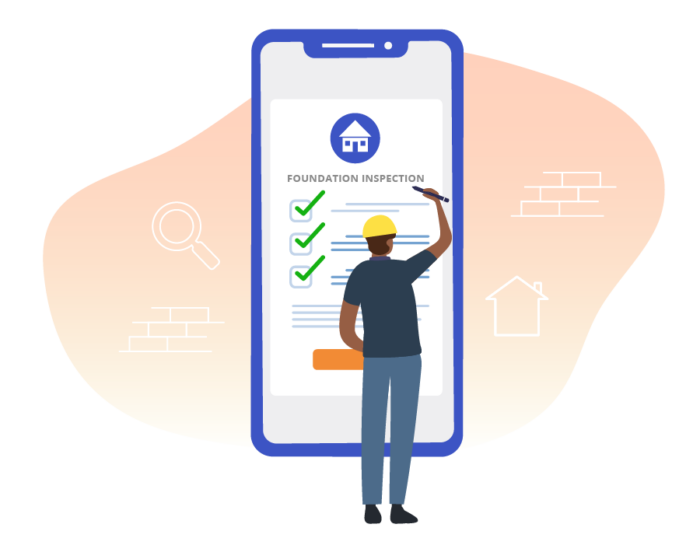
Online forms are replacing paper forms
Years ago, everything was done by hand. Can you imagine? You’d hand over a paper contract to your client in person, and then they’d sign it and have to send it back to you. You’d file this form in some sort of unwieldy cabinet, which someone would need to laboriously organize and alphabetize. You’d also have to make sure this original contract got filed away with the client’s other related forms — like payment information and the home inspection report form itself.
There’s a reason we did away with this system. Here are a few of the top reasons online forms are replacing paper forms:
- They allow you to work faster. There were a lot of bottlenecks when you had to deal with paper forms. You no longer have to rely on the post office and wait to share information with clients in person. You can now send and receive forms electronically, in a matter of minutes. If you use a form builder with robust integrations, this information will be automatically stored in a spreadsheet.
- They’re easily shareable. No more mailing contracts back and forth or waiting days to deliver a completed form to a client. No more waiting for a client to come in and sign a paper contract. Now you can quickly collect signatures and payment information with an online form and send back the necessary information in a seamless, efficient way.
- They let you keep all of your information in one place. Gone are the days of file cabinets. Online forms like Jotform easily collect all of your completed forms in an easy-to-navigate spreadsheet. You can also get email notifications whenever a form is sent to you so that you can keep track of what’s being filled out and when.
- They’re customizable. Once a paper form is printed, it’s what you have to work with, unless you want to waste lots of paper. With online forms, you can customize your forms to your specifications. If you realize you need to collect new information, you can easily update them to suit your evolving needs.
- They’re good for the planet. We all know paper isn’t the best for the environment. With online forms, you can ditch the paper and keep it all digital — meaning you’ll create less waste.
Not all online forms are created the same. You’ll want to make sure you choose a form creator that’s versatile and offers customizable features, plentiful templates, payment processing, and loads of integrations. Jotform can help with all of this — and it’s designed to make data collection simple so that you can spend more time doing great work for your clients.
Jotform is the online form solution that can help optimize your business
There are a lot of online forms out there. But what makes Jotform the right online form builder for optimizing your home inspection business? We’ll walk you through a few of the benefits of Jotform:
- There are tons of templates already available. A look through Jotform’s library of inspection forms will tell you one thing right off the bat: You have choices. Because countless users have found success with Jotform, there’s already a large collection of templates out there so you don’t have to worry about building something from scratch.
- But don’t worry; you can customize. You aren’t locked into the home inspection template you choose. You can even add CSS codes that give your form a little extra panache. At Jotform, we understand that your business is unique — so you need the ability to create unique forms too.
- You can also integrate to your heart’s content. Is there an app you or your team is using already that you’d like to work into your online form workflow? For instance, maybe your team uses Slack, and you’d like form responses to be sent to a Slack channel. There’s an integration for that. And there are plenty more you can choose from on the Jotform site. Integrations give your online forms even more unique functionality and help you get more work done on your terms.
- That means payment is ready to go. Some of Jotform’s most popular integrations are with payment processors like PayPal, which connect with your forms to help you collect one-time payments or subscription payments in an easy-to-use interface.
- Home inspectors have already gotten a lot out of JotForm. The wealth of inspection-related templates in the form library is a clear indication that plenty of home inspectors already use Jotform for their business needs. How will you use Jotform to optimize your home inspection business?
Why do you need home inspection software?
What are the advantages and uses of home inspection software?
There are plenty of home inspection software options on the market. They’ve helped countless home inspectors conduct their business in an organized, efficient fashion. Here are a few of the basic advantages of investing in home inspection software:

- Versatility. More and more home inspection software programs realize that home inspectors are working on the go. That’s why plenty of software options offer mobile capabilities, enabling you to use your software on iPhone or Android in addition to your desktop.
- Advanced features. From advanced report presentation to video and 360-degree imagery on your reports, many home inspection software programs are dedicated to helping you deliver stunning home inspection reports to your clients.
- Online customer support. The best home inspection software programs come with 24-7 online support so you can get questions cleared up in no time.
- Cloud services. Lots of home inspection software comes with cloud capabilities that enable ample storage and seamless syncing between your devices. Keep in mind that you often have to pay extra for these features.
- Flexible pricing. Maybe you aren’t ready to shell out a lot of money for home inspection software. In that case, you can dip your toes in the water with a free trial. Or you can spring for a more affordable pricing tier that may not provide the full range of features but will still give you much of the basic functionality.
You’ll probably find you get quite a bit of use out of your home inspection software. For instance, as you do an inspection, you can refer to your home inspection software on your phone. As you go through the home, you can take photos. You can then annotate these photos to point out concerning areas. You can add these photos to your reports and send then to your clients.
In this blog post, we go through some of the popular home inspection software on the market, outlining special features, pricing, and X-factors to help you decide which home inspection software is right for you and your business.
Jotform gives home inspectors just what they need
Home inspection is an on-the-go job. You’re visiting properties and meeting clients face to face. So you can’t be stuck behind a computer all day.
That’s where Jotform Mobile Forms comes in. Jotform Mobile Forms offers the full capabilities of Jotform right on your phone.
Now you can work from wherever, with the ability to create and populate forms on the go. You can also collect any sort of data you need — from pictures and video to voice memos and electronic signatures. The options are endless — and now your ability to enter data isn’t limited by the far-flung places your job takes you.
In this section, we’ll take a deep dive into the wide world of Jotform Mobile Forms, touching on stand-out features that can help you optimize your business.
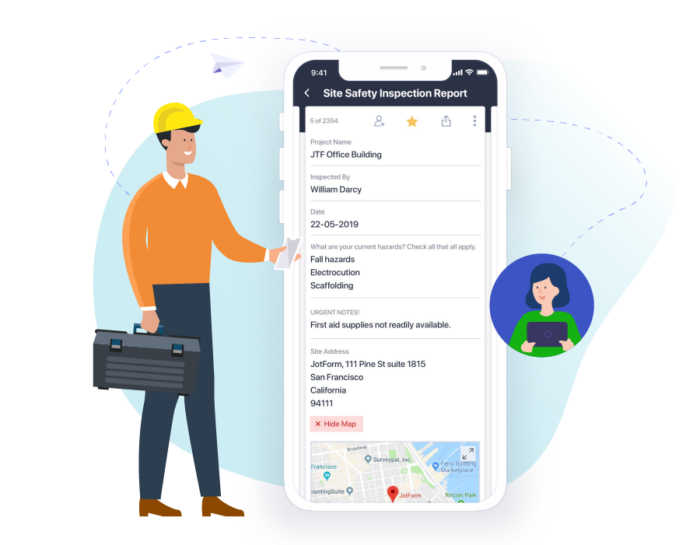
Jotform Mobile Forms features that stand out
Jotform Mobile Forms is transforming the way people use online forms. Most digital communication used to happen from behind a desktop, but things have changed. The rise of mobile has shifted the way people get work done and given rise to software that syncs across devices.
Jotform Mobile Forms is here to help you take advantage of this new normal. Here are a few features of Jotform Mobile Forms that can help you conduct business seamlessly:
- Offline data collection. Say you’re inspecting a new home. It probably isn’t outfitted with Wi-Fi yet. What if you don’t have a good cell phone signal? Well, you’re in luck, because Jotform Mobile Forms works offline, meaning you don’t need an internet connection or cell signal to collect responses. These offline form responses will sync with your Jotform account once you’re back online.
- Advanced data collection. You do more than just text on your phone. You take pictures, record videos and voice memos, send your location, and scan barcodes. All of this data can now be included in your forms — you can go beyond text and build forms capable of collecting rich data in a variety of formats. For instance, if you’re trying to explain to a client why their wiring is faulty, you can now record a video where you explicitly outline the defect — and then you can add this video directly to your report.
- Kiosk mode. Are you at a conference for home inspectors? Do you want to collect other inspectors’ contact information so that you can expand your network? Now you can collect this information easily with kiosk mode, which helps you securely gather form responses from a single device. Your form will refresh automatically as new information is added.
- Assign forms. Home inspectors don’t always work alone. Oftentimes you’ll have a partner with you. You can assign a form to another team member so that together you can send, view, and manage responses. As you do this, you can send feedback and track activity.
- Mobile Form Builder. Say you want to go in-depth on a home’s foundation — and maybe you want to build an entirely separate report for this foundation. Then why not build a quick form on the go that outlines the different elements of this foundation? It’s a convenient way to quickly build forms wherever your job takes you.
- Notifications. With customizable notifications, you’ll always know when new responses to your form are coming in. So if you’ve been waiting for a client to sign a contract, you can set your notification settings to alert you right away.
- Multiple sharing options. Want to send a client their report right away? Now you can with a simple tap. You can also share your forms to other mobile apps like Facebook, Twitter, WhatsApp, and Instagram.
Jotform Mobile Forms captures the power of Jotform and puts it on your phone or tablet. We understand that your job takes you places — and some of these places don’t have an internet connection. With offline mobile data collection, you have a whole new world of online form capabilities.
Jotform as home inspection software
With mobile capabilities, Jotform is poised to help you optimize your home inspection business. In this blog post, we’ll walk you through a day in the life of a typical home inspector — and show you how Jotform makes a home inspector’s life that much easier.


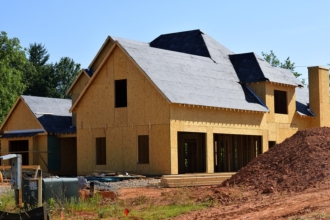



Send Comment:
3 Comments:
More than a year ago
Find out more on this topic by visiting the the website below:
More than a year ago
Very good informations for any one who is willing to start a new carrier in home inspection field.
More than a year ago
Anyone even a little involved in the home inspection business knows how much goes into running an inspection. The job is built on thoroughness and detail. You can’t leave any stone unturned. You need to collect tons of data and keep it organized.
Overall I was really impressed how much this page captured this central goal that all home inspectors share: to be comprehensive and approach their jobs with thoroughness. And it’s clear that Jotform understands how much home inspectors rely on both data and correspondence.
The data comes in when you’re doing the inspection and writing up reports. You have to hit every part of that checklist and give a solid indication of the home’s condition. You can’t skip anything. And the ability to provide images and video in your reports so seamlessly really can change the game for home inspectors. I wasn’t aware Jotform Mobile Forms was capable of that!
And home inspectors have to correspond with our clients along the way. We want an open channel of communication, and we want to turn around tasks quickly. We know how stressful it can be to buy a home. So we don’t want to be the ones adding stress to the home buyer’s life. That’s why the ability to quickly deliver, sign, and share contracts and reports during the inspection process is so vital.
Overall I appreciate all of the information and look forward to using Jotform in my business!